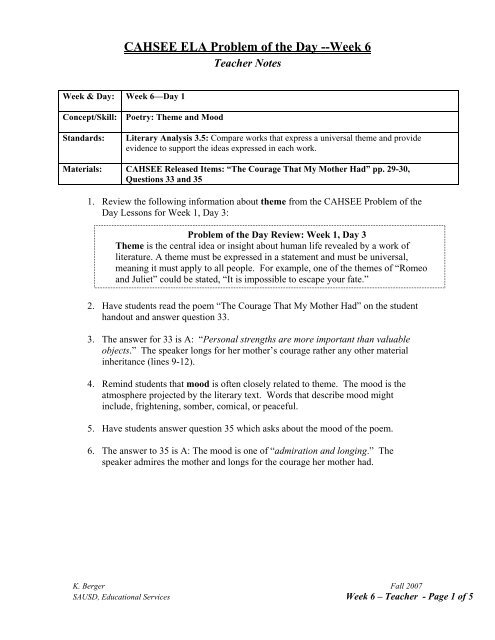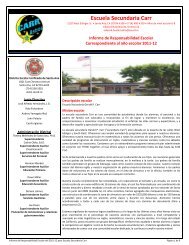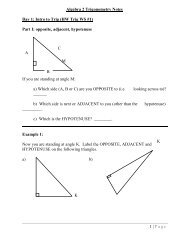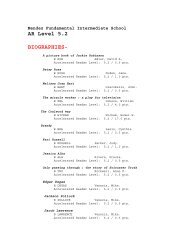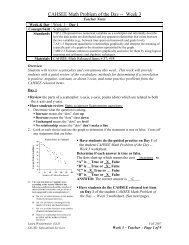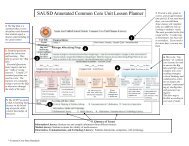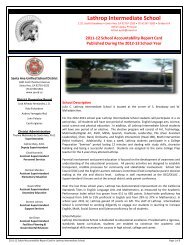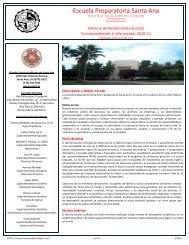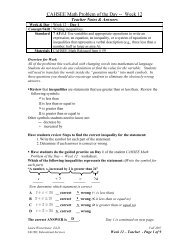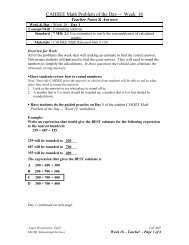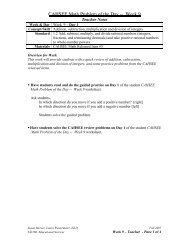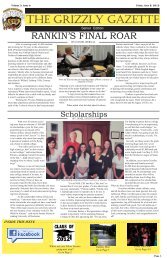CAHSEE ELA Problem of the Day --Week 6
CAHSEE ELA Problem of the Day --Week 6
CAHSEE ELA Problem of the Day --Week 6
Create successful ePaper yourself
Turn your PDF publications into a flip-book with our unique Google optimized e-Paper software.
<strong>CAHSEE</strong> <strong>ELA</strong> <strong>Problem</strong> <strong>of</strong> <strong>the</strong> <strong>Day</strong> --<strong>Week</strong> 6<br />
Teacher Notes<br />
<strong>Week</strong> & <strong>Day</strong>: <strong>Week</strong> 6—<strong>Day</strong> 1<br />
Concept/Skill: Poetry: Theme and Mood<br />
Standards:<br />
Literary Analysis 3.5: Compare works that express a universal <strong>the</strong>me and provide<br />
evidence to support <strong>the</strong> ideas expressed in each work.<br />
Materials: <strong>CAHSEE</strong> Released Items: “The Courage That My Mo<strong>the</strong>r Had” pp. 29-30,<br />
Questions 33 and 35<br />
1. Review <strong>the</strong> following information about <strong>the</strong>me from <strong>the</strong> <strong>CAHSEE</strong> <strong>Problem</strong> <strong>of</strong> <strong>the</strong><br />
<strong>Day</strong> Lessons for <strong>Week</strong> 1, <strong>Day</strong> 3:<br />
<strong>Problem</strong> <strong>of</strong> <strong>the</strong> <strong>Day</strong> Review: <strong>Week</strong> 1, <strong>Day</strong> 3<br />
Theme is <strong>the</strong> central idea or insight about human life revealed by a work <strong>of</strong><br />
literature. A <strong>the</strong>me must be expressed in a statement and must be universal,<br />
meaning it must apply to all people. For example, one <strong>of</strong> <strong>the</strong> <strong>the</strong>mes <strong>of</strong> “Romeo<br />
and Juliet” could be stated, “It is impossible to escape your fate.”<br />
2. Have students read <strong>the</strong> poem “The Courage That My Mo<strong>the</strong>r Had” on <strong>the</strong> student<br />
handout and answer question 33.<br />
3. The answer for 33 is A: “Personal strengths are more important than valuable<br />
objects.” The speaker longs for her mo<strong>the</strong>r’s courage ra<strong>the</strong>r any o<strong>the</strong>r material<br />
inheritance (lines 9-12).<br />
4. Remind students that mood is <strong>of</strong>ten closely related to <strong>the</strong>me. The mood is <strong>the</strong><br />
atmosphere projected by <strong>the</strong> literary text. Words that describe mood might<br />
include, frightening, somber, comical, or peaceful.<br />
5. Have students answer question 35 which asks about <strong>the</strong> mood <strong>of</strong> <strong>the</strong> poem.<br />
6. The answer to 35 is A: The mood is one <strong>of</strong> “admiration and longing.” The<br />
speaker admires <strong>the</strong> mo<strong>the</strong>r and longs for <strong>the</strong> courage her mo<strong>the</strong>r had.<br />
K. Berger Fall 2007<br />
SAUSD, Educational Services <strong>Week</strong> 6 – Teacher - Page 1 <strong>of</strong> 5
<strong>CAHSEE</strong> <strong>ELA</strong> <strong>Problem</strong> <strong>of</strong> <strong>the</strong> <strong>Day</strong> --<strong>Week</strong> 6<br />
Teacher Notes<br />
<strong>Week</strong> & <strong>Day</strong>: <strong>Week</strong> 6—<strong>Day</strong> 2<br />
Concept/Skill: Poetry: Tone<br />
Standards: Literary Analysis 3.9: Explain how voice, persona, and <strong>the</strong> choice <strong>of</strong> a narrator<br />
affect characterization and <strong>the</strong> tone, plot, and credibility <strong>of</strong> a text.<br />
Materials: <strong>CAHSEE</strong> Released Items: “The Courage That My Mo<strong>the</strong>r Had” pp. 29-30,<br />
Question 34<br />
1. Review <strong>the</strong> following information about tone from <strong>the</strong> <strong>CAHSEE</strong> <strong>Problem</strong> <strong>of</strong> <strong>the</strong><br />
<strong>Day</strong> Lessons for <strong>Week</strong> 1, <strong>Day</strong> 1.:<br />
<strong>Problem</strong> <strong>of</strong> <strong>the</strong> <strong>Day</strong> Review: <strong>Week</strong> 1, <strong>Day</strong> 1<br />
The tone <strong>of</strong> <strong>the</strong> text is <strong>the</strong> attitude <strong>the</strong> author or narrator takes towards a subject,<br />
a character, or <strong>the</strong> reader.<br />
2. Have students complete question 34 which asks students to find <strong>the</strong> phrase which<br />
best conveys <strong>the</strong> tone <strong>of</strong> <strong>the</strong> poem.<br />
3. The answer to 34 is B: “Oh, if instead she left to me.” This is <strong>the</strong> only answer<br />
choice which conveys <strong>the</strong> tone <strong>of</strong> sadness and longing.<br />
4. Ask students what tone is conveyed in <strong>the</strong> o<strong>the</strong>r answer choices. (Answers A and<br />
D reflect a tone <strong>of</strong> admiration <strong>of</strong> <strong>the</strong> mo<strong>the</strong>r’s strength. Answer C does not seem<br />
to convey any tone, although students may interpret this quote as nostalgic.)<br />
Note: Students may ask about <strong>the</strong> difference between tone and mood. Although<br />
<strong>the</strong>se two literary elements are similar, <strong>the</strong>y are still distinct from one ano<strong>the</strong>r. For<br />
example, a horror story, such as “Cask <strong>of</strong> Amontillado” by Edgar Alan Poe, may have<br />
a mood <strong>of</strong> horror; however, <strong>the</strong> tone, or <strong>the</strong> attitude <strong>of</strong> <strong>the</strong> narrator, may be quite<br />
detached or matter-<strong>of</strong>-fact.<br />
K. Berger Fall 2007<br />
SAUSD, Educational Services <strong>Week</strong> 6 – Teacher - Page 2 <strong>of</strong> 5
<strong>CAHSEE</strong> <strong>ELA</strong> <strong>Problem</strong> <strong>of</strong> <strong>the</strong> <strong>Day</strong> --<strong>Week</strong> 6<br />
Teacher Notes<br />
<strong>Week</strong> & <strong>Day</strong>: <strong>Week</strong> 6—<strong>Day</strong> 3<br />
Concept/Skill: Poetry: Stanzas and Repetition<br />
Standards: Literary Analysis 3.10: Identify and describe <strong>the</strong> function <strong>of</strong> dialogue, scene designs,<br />
soliloquies, asides, and character foils in dramatic literature.<br />
Materials: <strong>CAHSEE</strong> Released Items: “I’ve Watched” pp.31-32, Question 36<br />
1. Tell students that poetry is usually organized in units called stanzas. Ask<br />
students to preview <strong>the</strong> poem “I’ve Watched.” Ask <strong>the</strong>m how many stanzas <strong>the</strong><br />
poem has and how many lines are in each stanza. (There are 6 stanzas with 4<br />
lines each.)<br />
2. Review <strong>the</strong> concept <strong>of</strong> repetition in poetry. Tell students that poets <strong>of</strong>ten repeat<br />
words and phrases to emphasize <strong>the</strong>ir importance. Repetition is also frequently<br />
used as a sound device.<br />
3. Have students preview question 36 which asks about <strong>the</strong> organization <strong>of</strong> <strong>the</strong><br />
poem. Tell <strong>the</strong>m <strong>the</strong>y should pay attention to any examples <strong>of</strong> repetition in <strong>the</strong><br />
poem. After reading <strong>the</strong> poem, students should go back and answer <strong>the</strong> question.<br />
4. The answer for question 36 is B: The poem includes 5 stanzas <strong>of</strong> observation and<br />
1 <strong>of</strong> conclusion.<br />
5. Ask students which words are repeated in <strong>the</strong> first line <strong>of</strong> stanzas 1-5. ( The words<br />
are “I’ve Watched.”). These words reinforce <strong>the</strong> emphasis on observation in<br />
those stanzas)<br />
6. Finally ask students what conclusion is <strong>of</strong>fered in <strong>the</strong> last stanza. (The speaker<br />
concludes that even after all his intense watching, he is still no closer to solving<br />
nature’s mysteries.)<br />
K. Berger Fall 2007<br />
SAUSD, Educational Services <strong>Week</strong> 6 – Teacher - Page 3 <strong>of</strong> 5
<strong>CAHSEE</strong> <strong>ELA</strong> <strong>Problem</strong> <strong>of</strong> <strong>the</strong> <strong>Day</strong> --<strong>Week</strong> 6<br />
Teacher Notes<br />
<strong>Week</strong> & <strong>Day</strong>: <strong>Week</strong> 6—<strong>Day</strong> 4<br />
Concept/Skill: Poetry: Theme<br />
Standards:<br />
Literary Analysis 3.3: Analyze interactions between main and subordinate characters in a<br />
literary text (e.g., internal and external conflicts, motivations, relationships, influences) and<br />
explain <strong>the</strong> way those interactions affect <strong>the</strong> plot.<br />
Literary Analysis 3.5: Compare works that express a universal <strong>the</strong>me and provide<br />
evidence to support <strong>the</strong> ideas expressed in each work.<br />
Materials: <strong>CAHSEE</strong> Released Items: “I’ve Watched” pp.31-32, Questions 38 and 39<br />
1. Question 39 deals with <strong>the</strong> <strong>the</strong>me <strong>of</strong> <strong>the</strong> poem “I’ve Watched.” Since <strong>the</strong> <strong>the</strong>me<br />
is very similar to <strong>the</strong> conclusion <strong>the</strong> speaker makes in <strong>the</strong> last stanza (Question<br />
36), have students think back to that question and refer to <strong>the</strong> last stanza before<br />
answering 39.<br />
2. Have students answer Question 39.<br />
3. The answer for 39 is C: “Nature remains a mystery, regardless <strong>of</strong> our<br />
observations.”<br />
4. Next, have students preview question 38. Have <strong>the</strong>m try to guess <strong>the</strong> answer<br />
before referring to <strong>the</strong> text. After <strong>the</strong>y have guessed, have <strong>the</strong>m reread <strong>the</strong> text to<br />
confirm <strong>the</strong>ir answer choice.<br />
5. The answer for 38 is D: “The fishermen’s knowledge <strong>of</strong> <strong>the</strong> sea does not<br />
guarantee <strong>the</strong>m safety.”<br />
6. Ask how many students guessed <strong>the</strong> correct answer for 36 before looking at <strong>the</strong><br />
text. Point out that this answer supports <strong>the</strong> <strong>the</strong>me <strong>of</strong> <strong>the</strong> poem. No matter how<br />
much experience <strong>the</strong> sailor has on <strong>the</strong> sea, he never can understand its deepest<br />
mysteries.<br />
K. Berger Fall 2007<br />
SAUSD, Educational Services <strong>Week</strong> 6 – Teacher - Page 4 <strong>of</strong> 5
<strong>CAHSEE</strong> <strong>ELA</strong> <strong>Problem</strong> <strong>of</strong> <strong>the</strong> <strong>Day</strong> --<strong>Week</strong> 6<br />
Teacher Notes<br />
<strong>Week</strong> & <strong>Day</strong>: <strong>Week</strong> 6—<strong>Day</strong> 5<br />
Concept/Skill: Poetry: Figurative Word Meanings, Contextual Clues<br />
Standards: Word Analysis 1.2. Distinguish between <strong>the</strong> denotative and connotative meanings <strong>of</strong> words<br />
and interpret <strong>the</strong> connotative power <strong>of</strong> words.<br />
Materials: <strong>CAHSEE</strong> Released Items: “I’ve Watched” pp.31-32, Questions 37<br />
1. Review figurative language which was introduced in <strong>the</strong> <strong>Problem</strong> <strong>of</strong> <strong>the</strong> <strong>Day</strong>, <strong>Week</strong> 1,<br />
<strong>Day</strong> 5.<br />
<strong>Problem</strong> <strong>of</strong> <strong>the</strong> <strong>Day</strong> Review: <strong>Week</strong> 1, <strong>Day</strong> 5<br />
Figurative Language: Language which cannot be understood on a literal level. “That boy has a real<br />
chip on his shoulder.”<br />
Simile: A comparison using like or as. “Her eyes were as blue as <strong>the</strong> ocean.”<br />
Metaphor: A direct comparison. “My bro<strong>the</strong>r’s room was an absolute pigsty.”<br />
Implied Metaphor: A metaphor where <strong>the</strong> comparison between <strong>the</strong> two things is implied instead <strong>of</strong><br />
directly stated. “The greedy landlord sli<strong>the</strong>red out <strong>of</strong> <strong>the</strong> building.” (The landlord is implicitly<br />
compared to a snake.)<br />
Personification: A type <strong>of</strong> metaphor where nonliving things are given human qualities. “The bell<br />
screamed that it was <strong>the</strong> end <strong>of</strong> <strong>the</strong> school day.”<br />
2. Explain that sometimes a figurative meaning might be implied by only one word.<br />
3. Have students answer question 37 paying attention to <strong>the</strong> word lashed.<br />
4. The answer is D: “The word lashed suggests that <strong>the</strong> ocean is being whipped.”<br />
5. Ask <strong>the</strong> students how <strong>the</strong> wind could whip <strong>the</strong> ocean. They might say <strong>the</strong> wind is<br />
violently striking <strong>the</strong> ocean or that <strong>the</strong> wind is personified.<br />
6. Have students go back to <strong>the</strong> poem (lines 18-20) to look for contextual clues<br />
which support this answer. The context suggests that <strong>the</strong> wind is something<br />
violent which “makes a fool out <strong>of</strong> fisherman.” Therefore, students could have<br />
eliminated answers A (soo<strong>the</strong>d) and C (sailed). The wind could possible trouble<br />
(answer B) <strong>the</strong> ocean, but if so, how would this endanger <strong>the</strong> fisherman?<br />
7. Before closing, point out how all <strong>of</strong> <strong>the</strong> questions for this poem are all related to<br />
<strong>the</strong> big idea or <strong>the</strong>me. Students should look for <strong>the</strong>se relationships when<br />
answering <strong>the</strong> questions. Seeing <strong>the</strong> relationships between questions may provide<br />
<strong>the</strong>m with clues for finding <strong>the</strong> correct answer.<br />
K. Berger Fall 2007<br />
SAUSD, Educational Services <strong>Week</strong> 6 – Teacher - Page 5 <strong>of</strong> 5


